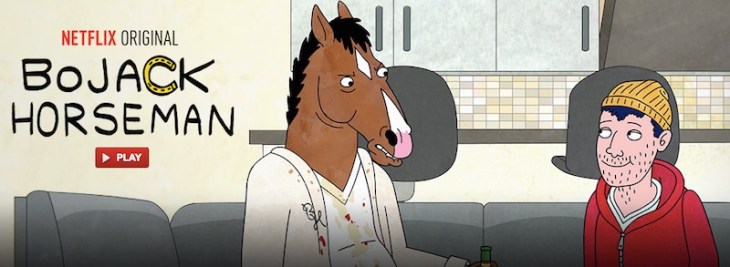When BoJack Horseman premiered on Netflix in August, it was with a lot less fanfare than we’d seen for House of Cards or Orange Is The New Black. (Heck, I think people are more excited about Netflix streaming all 10 seasons of Friends.) Even so, now that I’m looking back, BoJack was easily the high point of the year’s TV, at least for me. It also marked the moment when I fully got on-board with the company’s ambitions for original content.
BoJack Horseman, for those of you who haven’t caught up, is an animated show (created by Raphael Bob-Waksberg, with designs by cartoonist Lisa Hanawalt), starring Will Arnett as a washed up star of a Full House-style ’80s sitcom. The 12-episode first season focused on BoJack’s relationship with Diane Nguyen, the ghostwriter of his long-overdue memoir. And, yes, he’s a talking horse — half of the other characters are anthropomorphized animals, too.
The show gets a lot of mileage out of mixing showbiz humor with surreal jokes where characters revert to their animal instincts. I was on-board pretty much from the start (the first episode has Patton Oswalt as a Penguin/penguin book editor, and an amazing gross-out gag involving cotton candy that I don’t want to spoil — what more do you want?), but TV critics were lukewarm at first.
Where BoJack really finds it’s footing is about halfway through that first season. It stays funny, but the humor moves closer to the story’s edges, as the character’s self-loathing and self-destructive behavior become harder to hide with jokes. The penultimate episode features the animated drug trip to end all animated drug trips, and the finale closes with an absolutely perfect final image. (To be honest, the ending is so good that the surprise Christmas special that just came out felt a little anticlimactic.)
What the hell is that stuff doing in a goofy cartoon? As Bob-Waksberg explained in an Ask Me Anything session on Reddit, “I always felt like BECAUSE BoJack was a goofy cartoon horse, we could explore darker, more real areas and emotions than we ever could if the show was live action, without feeling indulgent or maudlin.”
Like I mentioned earlier, Netflix’s ambitions for the show were probably much lower than they were for its big titles. (House of Cards got a giant sign in Times Square; BoJack got a mural in Williamsburg.) In its most recent earnings report, Netflix described the show as its “expansion into the popular adult animated comedy genre,” and its bar for success was that it “drew more viewers in its first few weeks than any of these established network shows [Archer, Futurama, and Bob’s Burgers] over a comparable period on Netflix.” And hooray, that was good enough to earn the show a second season.
Anyway, amidst all the hype around Netflix’s growth and its expensive bets, I just wanted to celebrate the fact that in 2014, it made room for this very weird, very good show.
